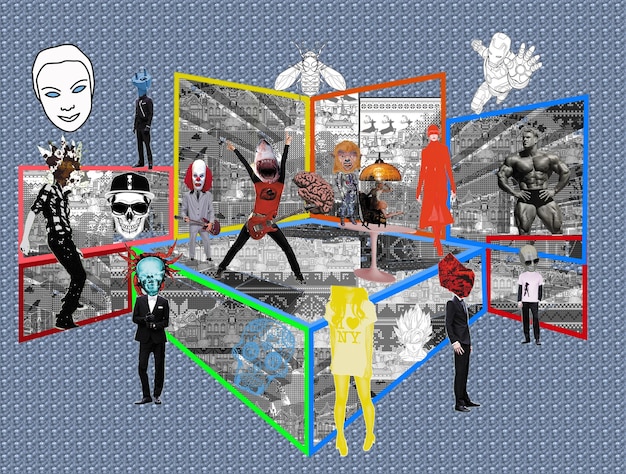Unveiling the Shocking Plot Twists of

The biggest plot twists in history often involve unexpected character revelations, unforeseen betrayals, or shocking deaths that completely change the trajectory of the narrative, leaving audiences stunned and eager for more.
Dive into the captivating world of and brace yourself as we uncover the most shocking plot twists that have left fans gasping. From unexpected betrayals to mind-bending revelations, prepare to have your perceptions challenged and your expectations shattered as we dissect the moments that redefined storytelling in . Get ready, spoilers ahead!
The Anatomy of a Plot Twist: Understanding What Makes Them Unforgettable
Plot twists are the lifeblood of any gripping , injecting suspense, surprise, and emotional resonance into the narrative. But what exactly constitutes a truly unforgettable plot twist? It’s more than just a simple surprise; it’s a carefully crafted revelation that recontextualizes everything we thought we knew about the story.
The Element of Surprise
A successful plot twist must, first and foremost, be surprising. It needs to catch the audience off guard, subverting their expectations and challenging their preconceived notions about the characters and the storyline. Without the element of surprise, the twist falls flat, failing to deliver the intended impact.
Emotional Impact
Beyond mere surprise, a great plot twist evokes a powerful emotional response. It can be shocking, heartbreaking, infuriating, or even cathartic. The emotional resonance is what lingers with the audience long after the credits roll, solidifying the twist’s place in their memory. It’s the emotional connection that transforms a simple plot device into a truly unforgettable moment.

Here are some key elements that elevate a plot twist from predictable to legendary:
- The unexpected reveal of a character’s true identity.
- A shocking betrayal that shatters alliances and friendships.
- The sudden death of a beloved character.
- The unveiling of a hidden agenda or secret plan.
In conclusion, a truly unforgettable plot twist is a delicate balance of surprise and emotional impact. It’s a moment that not only catches the audience off guard but also resonates with them on a deeply personal level, leaving a lasting impression that shapes their interpretation of the entire narrative.
Iconic Betrayals: When Allies Become Enemies in
One of the most potent sources of plot twists comes from the betrayal of trust. When a character we’ve come to trust and admire turns against the protagonist, it can be a truly devastating and unforgettable moment. These betrayals often serve as turning points in the story, forcing the hero to confront their own vulnerabilities and question their judgment.
Betrayals in can range from subtle acts of deceit to outright acts of aggression. The impact of the betrayal often depends on the relationship between the betrayer and the betrayed. The closer the bond, the more painful the betrayal.
Consider these examples of well-executed betrayals in :
The False Mentor
This trope involves a character who initially presents themselves as a guide or ally to the protagonist, only to later reveal their true, malevolent intentions. This betrayal often hits harder because the protagonist has placed their trust and faith in the mentor figure, making the betrayal a deeply personal and damaging experience.
The Double Agent
This classic trope features a character who is secretly working against the protagonist, often while pretending to be on their side. The double agent can be particularly effective in creating suspense and paranoia, as the audience is left wondering who they can truly trust.

Here are some reasons why betrayals are so effective as plot twists:
- They create emotional complexity and moral ambiguity.
- They force characters to evolve and adapt.
- They raise the stakes and increase the sense of urgency.
- They challenge the audience’s assumptions and expectations.
In short, betrayals are a powerful tool for creating compelling and memorable moments in . By subverting expectations and challenging the audience’s sense of trust, betrayals can add depth, complexity, and emotional resonance to the narrative.
Unforeseen Deaths: Shaking the Foundation of
The death of a major character can be a shocking and unforgettable event, particularly when it comes as a complete surprise. Unforeseen deaths can have a profound impact on the narrative, creating emotional turmoil, shifting alliances, and raising the stakes of the conflict. Often, these deaths force the remaining characters to confront their own mortality and re-evaluate their priorities.
The impact of an unforeseen death is often amplified by the character’s popularity and importance to the story. The more beloved the character, the more devastating their loss.
Consider these examples of unforeseen deaths that shook the foundation of :
- A seemingly invincible hero is suddenly killed by a seemingly weaker foe.
- A character who has been foreshadowed to survive is unexpectedly killed off.
- A beloved character sacrifices themselves to save their friends or allies.
- A character’s death is revealed to be a key piece of a larger conspiracy.
In conclusion, unforeseen deaths can be a powerful tool for creating dramatic and emotional moments in . By subverting audience expectations and challenging their assumptions about character safety, these deaths can add depth, complexity, and a sense of realism to the narrative. However, it’s crucial to handle such deaths with care and sensitivity, ensuring that they serve a meaningful purpose and contribute to the overall story.
The Reveal of Hidden Identities: Unmasking the Truth in
The reveal of a character’s hidden identity is another classic plot twist that can have a significant impact on the story. These revelations often involve characters who have been hiding their true nature or intentions, leading to shocking discoveries that alter the audience’s perception of the entire narrative. The reveal of a hidden identity can create suspense, paranoia, and emotional turmoil, as characters grapple with the implications of the truth.
The effectiveness of a hidden identity reveal often depends on the character’s importance to the story and the extent to which they have been able to deceive those around them.
Consider these examples of hidden identity reveals that captivated audiences in :
- A seemingly ordinary character is revealed to be a powerful figure from the past.
- A character who appears to be an ally is revealed to be a spy or double agent.
- A character’s true identity connects them to a major villain or antagonist.
- A character’s hidden identity is revealed to be the key to solving a mystery or defeating an enemy.
In short, the reveal of a hidden identity can be a powerful tool for creating surprise and intrigue in . By carefully crafting the character’s deception and building suspense leading up to the reveal, writers can deliver a truly unforgettable moment that shakes the foundations of the story.
Time Manipulation and Alternate Realities: Bending the Rules of
Time manipulation and alternate realities offer a unique opportunity to create mind-bending plot twists that challenge the audience’s understanding of the fundamental laws of the . These twists can involve characters traveling through time, experiencing alternate versions of events, or discovering that their reality is not what they thought it was. By bending the rules of time and space, writers can introduce unexpected possibilities and create moments of profound disorientation and revelation.
The effectiveness of time manipulation and alternate reality twists often depends on the clarity and coherence of the rules governing these concepts within the narrative. If the time travel or alternate reality mechanics are confusing or inconsistent, the twist can feel arbitrary and unsatisfying.
Consider these examples of time manipulation and alternate reality twists that pushed the boundaries of storytelling in :
- A character discovers that they are trapped in a time loop, reliving the same events over and over again.
- A character travels to an alternate reality where their life is dramatically different.
- A character’s actions in the past have unforeseen consequences on the present and future.
- A character discovers that their entire reality is a simulation or illusion.
In conclusion, time manipulation and alternate realities can be a powerful tool for creating mind-bending plot twists in . By carefully considering the implications of these concepts and establishing clear rules for their implementation, writers can deliver truly unforgettable moments that challenge the audience’s perception of reality.
Red Herrings and Misdirection: The Art of Deception in
The use of red herrings and misdirection is a key element in crafting effective plot twists. Red herrings are misleading clues or information that are designed to distract the audience from the true solution or revelation. Misdirection involves manipulating the audience’s attention, causing them to focus on the wrong details or characters. By skillfully employing these techniques, writers can create a sense of suspense and anticipation, leading to a more impactful and surprising plot twist.
The effectiveness of red herrings and misdirection often depends on their subtlety and plausibility. If the red herring is too obvious or the misdirection is too heavy-handed, the audience may see through the deception and anticipate the twist.
Consider these examples of red herrings and misdirection used to great effect in :
- Presenting a character as the prime suspect in a crime, only to reveal that they are innocent and someone else is the culprit.
- Leading the audience to believe that a character is dead, only to reveal that they are alive and in hiding.
- Focusing on a seemingly important detail, only to reveal that it is irrelevant to the central plot.
- Creating a sense of competition or rivalry between characters, only to reveal that they are secretly working together.
In short, red herrings and misdirection are essential tools for creating suspense and surprise in . By carefully crafting these deceptive elements and integrating them seamlessly into the narrative, writers can deliver truly unforgettable plot twists that leave the audience guessing until the very end.
The Future of Twists: What’s Next for Storytelling
As audiences become more sophisticated and familiar with traditional plot twist techniques, writers must continue to innovate and find new ways to surprise and challenge them. The future of twists in storytelling lies in pushing the boundaries of genre conventions, exploring uncharted narrative territory, and embracing new technologies that can enhance the immersive and interactive experience.
One potential avenue for innovation is the integration of artificial intelligence into the writing process. AI could be used to generate new plot ideas, analyze audience reactions, and personalize the narrative experience. However, it’s crucial to ensure that AI is used as a tool to enhance human creativity, rather than replace it.
Here are some potential trends that could shape the future of plot twists in :
- The use of unreliable narrators who deliberately mislead the audience.
- The incorporation of interactive elements that allow viewers to influence the story’s outcome.
- The exploration of complex moral dilemmas with no easy answers.
- The blurring of the lines between reality and fiction.
In conclusion, the future of twists in storytelling is bright, but it requires a willingness to experiment, innovate, and collaborate. By embracing new technologies and pushing the boundaries of narrative conventions, writers can continue to surprise, challenge, and captivate audiences for years to come.
| Key Concept | Brief Description |
|---|---|
| 🤯 Unexpected Betrayals | Alliances crumble when trusted characters become foes, shaking the foundations of the story. |
| 💀 Unforeseen Deaths | Major characters meet shocking ends, altering the narrative and raising the stakes. |
| 🎭 Hidden Identities | Characters reveal their true selves, challenging perceptions and rewriting history. |
| ⏱️ Time Manipulation | Altering timelines or creating alternate realities to introduce unexpected possibilities. |
Frequently Asked Questions
▼
A shocking plot twist combines surprise with emotional impact. It subverts expectations and resonates deeply, leaving a lasting impression.
▼
Betrayals add complexity, force character evolution, and raise stakes. They challenge trust and create moral ambiguity within the narrative.
▼
Unforeseen deaths challenge assumptions about character safety, adding depth and realism. They evoke strong emotional reactions and alter character trajectories.
▼
Hidden identities create suspense and intrigue, altering audience perceptions. They often link characters to villains or unlock mysteries within the story.
▼
Time manipulation bends reality, introducing alternate outcomes. It challenges understanding and creates disorientation, provided it follows defined rules.
Conclusion
From betrayals that shatter alliances to unforeseen deaths that reshape destinies, the best plot twists in are those that dare to subvert our expectations and leave a lasting impact. As storytelling continues to evolve, we can expect even more innovative and mind-bending twists that will challenge our perceptions and redefine the boundaries of the genre.


![Exploring [Topic]: Spoilers, Theories, and Predictions Exploring [Topic]: Spoilers, Theories, and Predictions - Cover Image](https://spoilernew.com/wp-content/uploads/2025/06/spoilernew.com_31_1750193099_cff22aee_cover-360x180.jpg)


